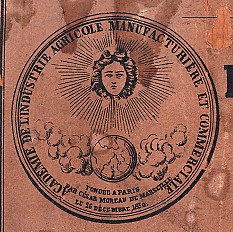Within a wooden frame with ebony finish is a delicate painting of a village scene, a country road with farmers and animals in the foreground, a canal with arched bridge with railroad trestle, boats, village building onto the hillside including homes, church, and windmill. The painting is constructed in two dimensions with the railroad trestle framing the front section and disguising the mechanical track upon which the train runs. There are several original and rare paper labels on the backside indicating the deposed system of animation developed by Xavier Tharin le 20 Juin, 1843, Borel Successor". Another label indicates two tunes, Pauline Valse and Le Bord du Lac Leman.
Movements: When the string is pulled it activates the music and movement simultaneously. The railroad crosses the bridge, and the windmill turns. Music plays.
Historical References: Xavier Tharin was creating his mechanical sand, pull-string and clockwork animated scenes as early as 1843. By that date he had already been awarded a Medal of Honor for his designs. Sometime during the 1860's Tharin was succeeded by his apprentice, Henri Borel. The animated tableau shown here was produced during the Borel period, and it is an indication of Tharin's fine reputation that Borel continued to use Tharin's name. In devising the mechanism of this tableau, the Tharin firm was challenged to find a system that would simultaneously start and stop the animation and the music, each of which required an independent wind-spring. Tharin solved the problem with a simple drawstring that connected all the mechanisms. Another example of this rare labeled piece with a different scene is to be found in the Murtogh D. Guinness collection at the Morris Museum. Circa 1860.



